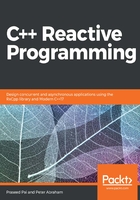
Conventions used
There are a number of text conventions used throughout this book.
CodeInText: Indicates code words in text, database table names, folder names, filenames, file extensions, pathnames, dummy URLs, user input, and Twitter handles. Here is an example: "The preceding code snippet initializes a structure by the name of WNDCLASS (or WNDCLASSEX for modern systems) with a necessary template for a window."
A block of code is set as follows:
/* close connection to server */
XCloseDisplay(display);
return 0;
}
When we wish to draw your attention to a particular part of a code block, the relevant lines or items are set in bold:
/* close connection to server */
XCloseDisplay(display);
return 0;
}
Any command-line input or output is written as follows:
$ mkdir css
$ cd css
Bold: Indicates a new term, an important word, or words that you see onscreen. For example, words in menus or dialog boxes appear in the text like this. Here is an example: "In Windowing parlance, it is called a message loop."
Warnings or important notes appear like this.
Tips and tricks appear like this.